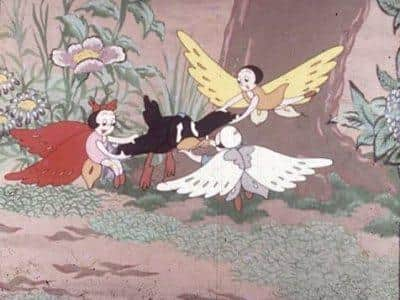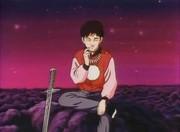The appeal and reviews of "Flowers and Butterflies": Beautiful visuals and a moving story

Flowers and Butterflies - Flower Butterfly - Appeal and EvaluationThe short animated film "Flowers and Butterflies," released in 1954, made a strong impression on audiences at the time with its unique story and colorful visuals. The film depicts the adventures of anthropomorphized butterflies playing in the spring sunshine, rescuing a baby bird and seeking shelter from the rain. Below, we will introduce detailed information and reviews of this film, as well as recommended points. ■ Public Mediatheater ■ Original MediaAnime Original ■ Release dateOctober 1954 ■Distribution companyOku Shokai ■Frequencies10 min ■ Number of EpisodesEpisode 1 ■ DirectorOku Shokai Limited Partnership [Produced by] / Chiyogami Eigasha [Production] ■ ProductionChiyogami Eigasha Co., Ltd. Oku Shokai [Produced and Provided], Chiyogami Eigasha [Work] (NFC notation) ■ Storydetail Anthropomorphized white, red, and yellow butterflies play in the spring sunlight. They help a crying baby bird that has fallen out of its nest. Soon it starts to rain heavily, and the butterflies ask a white lily for shelter, but only white butterflies are allowed in. The three friendly butterflies have no choice but to ask a red rose, but she also refuses, saying only red butterflies are allowed in. Finally, they ask a yellow tulip for shelter, but she refuses all butterflies except the yellow butterfly. The three butterflies search for a place to shelter from the rain, but the wind and rain are strong, and their wings gradually become heavier. ■ Main staffdetail・Artwork by Nobuo Ofuji ・Direction by Nobuo Ofuji ・Background by Miya x Fumio (NFC notation) Miyayoshi Fumio (Japanese Animation Film History p.245 notation) Evaluation and appeal of the workDespite its short running time, "Flowers and Butterflies" draws the audience in with its profound message and beautiful visuals. Below, we take a closer look at the appeal and reviews of this work. The appeal of the storyThe story of this work begins with a scene of personified butterflies playing in the spring sunshine. White, red, and yellow butterflies are depicted to symbolize their respective colors, creating a beautiful scene that evokes the arrival of spring. However, the story soon changes and moves to a scene where a crying baby bird is rescued after falling from its nest. This scene emphasizes the kindness and cooperation of the butterflies, giving the audience a warm feeling. However, the story centers on the adventures of the butterflies after a heavy rain begins to fall. The butterflies seek shelter from the rain on white lilies, red roses, and yellow tulips, but they are all only willing to accept butterflies of their own color. This scene symbolically depicts issues of discrimination and exclusivity. In the end, the importance of mutual help and friendship is emphasized when a baby bird sheds the leaves to save the butterflies. Although this story is an animation for children, it deals with deep themes and contains many elements that make the audience think. In particular, it has been praised for depicting social diversity and the difficulty of coexistence within it by dividing the butterflies into different colors. Visual appealThe visuals of "Flowers and Butterflies" are characterized by their rich colors and attention to detail. The illustrations are by Nobuo Ofuji, who realistically depicts the movements and expressions of the butterflies, giving the audience a lively impression. In addition, the backgrounds are by Fumio Miyagi (Miya x Fumio), who beautifully depicts the spring nature, enhancing the overall atmosphere of the work. In particular, the butterflies were color-coded to maximize the effect of color. By drawing white, red, and yellow butterflies in their respective colors, the visual impact is emphasized and it is also linked to the theme of the story. In the scene where the butterflies seek shelter from the rain, the rain and the movement of the wind are depicted realistically, giving the audience a sense of presence. The appeal of these visuals demonstrates the high level of technology and artistry of the time, and has elements that are still relevant in modern animation works. In particular, the use of color and the depiction of nature make a strong impression on the audience and help convey the message of the work more deeply. The charm of music and soundKyosuke Kami, who composed the music, provided beautiful melodies to enhance the atmosphere of the film. In particular, light and cheerful music is used in the scene where the butterflies play in the spring light, making the audience feel the arrival of spring. In addition, music is used to increase the tension in the scene after the heavy rain begins to fall, adding excitement to the development of the story. Shichiyokai, who was in charge of the dialogue, played a role in expressing the voices of the butterflies realistically, helping the audience empathize with them. In particular, in the scene where the baby bird is crying and the butterflies are seeking shelter from the rain, the voice acting emphasizes the emotions of the story and leaves a deep impression on the audience. In addition, Meguro Studio, which was in charge of recording, improved the quality of the sound, raising the overall perfection of the work. The appeal of the music and sound enhances the atmosphere of the work and leaves a strong impression on the audience. In particular, the music and sound are used in conjunction with the development of the story, providing the audience with an emotional experience. Evaluation of the workDespite its short running time, "Flowers and Butterflies" has been praised for its profound message and beautiful visuals that draw the audience in. It has been especially praised for the theme of the story, the colorfulness of the visuals, and the quality of the music and sound. As for the story, it has been praised for dealing with deep themes such as discrimination, exclusivity, mutual help and friendship, despite being an animation for children. In particular, the butterflies are divided by color, depicting social diversity and the difficulty of coexistence within it. Furthermore, the final scene in which the baby bird saves the butterflies emphasizes the importance of mutual help and friendship, giving the audience a warm feeling. In terms of visuals, the skill and artistry of the illustrator, Nobuo Ofuji, and the background artist, Fumio Miyagi (Miya x Fumio), have been highly praised. In particular, the movements and expressions of the butterflies and the depiction of nature are depicted realistically, leaving a strong impression on the audience. In addition, the use of color, the depiction of rain, and the movement of the wind are depicted realistically, enhancing the atmosphere of the work as a whole. Regarding the music and sound, the beautiful melodies of Kami Kyosuke, the realistic voice acting of Shichiyokai, and the high quality recordings of Meguro Studio have been highly praised. In particular, the music and sound are used in conjunction with the development of the story, providing the audience with an emotional experience. The high quality of the music and sound also enhances the overall perfection of the work. Recommended pointsDespite its short running time, "Flowers and Butterflies" draws the audience in with its profound message and beautiful visuals. Below, we will introduce the recommended points of this film. It's aimed at kids, but it deals with deep themes.Although this is an animation aimed at children, it deals with deep themes such as discrimination, exclusivity, mutual help and friendship. In particular, the butterflies are separated by color, depicting social diversity and the difficulty of coexistence within it, which has attracted attention. Furthermore, in the final scene where the baby bird rescues the butterflies, the importance of mutual help and friendship is emphasized, giving a warm feeling to the audience. This is one of the points that we recommend, as it contains many elements that will get adults and children thinking. Colorful visualsThe visuals of this work are characterised by their rich colours and attention to detail. The skill and artistry of the illustrator, Ofuji Nobuo, and background artist, Miyagi Fumio (Miya x Fumio), have been highly praised, with the movements and expressions of the butterflies and the depiction of nature being depicted realistically. The use of colours, the depiction of rain and the movement of the wind are also realistically drawn, enhancing the overall atmosphere of the work. This aspect makes a strong impression on the audience and plays a role in conveying the message of the work more deeply. Beautiful music and high quality soundThe music and sound of this work have been highly praised for their quality. In particular, Kami Kyosuke's beautiful melodies, Shichiyokai's realistic voice acting, and Meguro Studio's high-quality recordings enhance the atmosphere of the work. Furthermore, the music and sound are used in conjunction with the development of the story, providing the audience with an emotional experience. This aspect enhances the overall quality of the work and plays a role in leaving a strong impression on the audience. summaryDespite its short running time, "Flowers and Butterflies" draws in the audience with its profound message and beautiful visuals. It has been highly praised for the theme of the story, the colorfulness of the visuals, and the quality of the music and sound, and contains many elements that will make both children and adults think. In particular, it is recommended for its deep themes of discrimination, exclusivity, mutual help and friendship, as well as for its colorful visuals, beautiful music and high-quality sound. Although this is a short animated film from 1954, it contains elements that are common to modern animation works, so we highly recommend that you watch it at least once. |
<<: Japan's Toy Box: The Appeal and Evaluation of Anime
Recommend
Mononoke: The appeal of a unique worldview and detailed storytelling
"Mononoke": A moving tale of exorcism t...
HBO to order three new shows, including Justice League Dark
According to foreign media Variety, the HBO Max s...
The new movie version of "Penguin Tank" is scheduled to be released on July 22
The official release of the new theatrical versio...
Mission: Impossible 7 and 8 will no longer be filmed in a row, and Cruise needs to promote Top Gun 2
"Mission: Impossible 7" and "Missi...
"The Maid I Hired Recently Is a Bit Strange" Confirmed to Be Made into a TV Animation
The original work of cartoonist Konbu Wakame and ...
Spider-Man: No Return movie trailer leaks: Spider-Man is accused of murdering Mysterio
Recently, a trailer video of "Spider-Man: No...
The appeal and reviews of "NOIR": A dark worldview and detailed storytelling
The charm and depth of "NOIR": Looking ...
BURN THE WITCH Special Edition: A fascinating new adventure - review and impressions
BURN THE WITCH Special Edition - The beginning of...
Guan Hu's anti-Japanese war film "Eight Hundred" cancels summer release date and will announce new release date
The official Weibo account of the movie "Eig...
"Black Panther 2" actress Letitia Wright: The sequel is already in the works
At this week's Golden Globes, actress Letitia...
The appeal and reviews of Ponkikki Meisaku World: A world of anime that can be enjoyed by both children and adults
Ponkikki Meisaku World - Detailed review and reco...
APPLESEED ⅩⅢ Testament #3/Movie 1 - In-depth review and rating
"Appleseed XIII Testament" - Masamune S...
New cast of the live-action movie "Violent Action" Kanna Hashimoto plays the role of a killer girl
The official live-action movie "Violent Acti...
Sengoku Majin GoShogun: The appeal and reviews of the TV compilation
Sengoku Majin GoShogun (TV Digest) - Sengoku Maji...
Karakuri no Kimi - The charm of a unique world view and detailed storytelling
"Karakuri no Kimi" - A story of a girl ...









